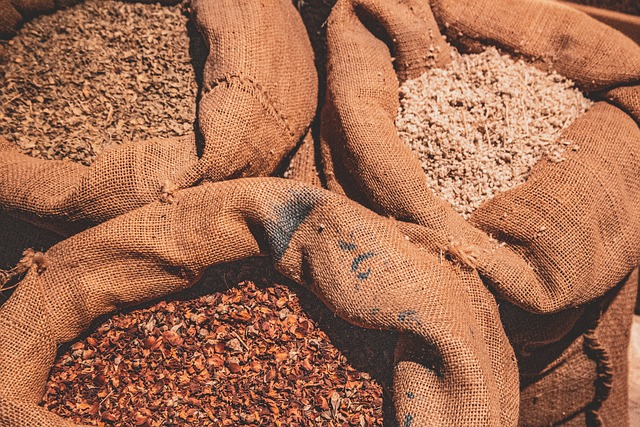In the vast expanse of grain fields that stretch across the countryside, a silent dance unfolds. Beneath the golden sun, the invisible hand of the neutral grains market orchestrates a delicate balance, sowing the seeds of insight in its wake. Welcome, dear readers, to a captivating discourse where the mysteries of this enigmatic market unfurl, revealing a world that teems with possibilities and untold revelations. In this article, we embark on a journey that transcends the bounds of traditional analysis, delving deep into the heart of a neutral grains market, where creativity flourishes, and neutrality prevails. Prepare to be amazed as we unravel the tapestry of this intricate dance, shedding light on its complexities and marveling at the profound insights it may unearth. So gather your curiosity and join us on this extraordinary adventure, as together we dive into the captivating realm of the neutral grains market.
Sowing the Seeds of Insight: A Neutral Grains Market Discourse
The world of grains market is a complex ecosystem, where knowledge and understanding hold the key to successful endeavors. In this discourse, we delve into the intricate dynamics of this neutral realm, where all grains intertwine, creating an intricate tapestry of insights.
Embarking on this journey, we explore the vast expanse of global grains trade, where suppliers, buyers, and enthusiasts converge to navigate the enigma of supply and demand. Here, neutrality becomes a compass, guiding us through the vast sea of information, as we sow the seeds of wisdom and sow the seeds of growth.
- Pricing Insights: We examine the factors influencing grain prices, from weather patterns to geopolitical dynamics, unraveling a web of interconnected forces that shape the grains market.
- Market Trends: Delve into the latest trends driving the grains market, from emerging technologies in farming practices to shifts in consumer preferences, shedding light on the path toward sustainable growth.
- Trade Relations: Explore the intricate web of global trade relations, examining the impacts of tariffs, sanctions, and diplomatic intricacies on the grains market, fostering a comprehensive understanding of the market’s interconnectedness.

– Analyzing Market Trends and Dynamics: Unraveling the Complexities of the Grain Industry
Understanding the Shifting Landscape of the Grain Industry
In the ever-changing world of agriculture, the grain industry remains at the forefront of economic and environmental discussions. As consumers become more conscious of their food choices, and governments strive for sustainable development, the complexities of the grain market have intensified. To navigate this intricate industry, it is crucial to analyze the market trends and dynamics that shape it. But what are these trends and how do they impact different aspects of the grain industry?
The first trend we observe is the growing demand for organic and non-GMO grains. Consumers are increasingly opting for healthier and environmentally-friendly options, driving the need for more sustainable farming practices. Farmers everywhere are adapting to this shift, adopting organic methods, and acquiring certifications to cater to this niche market. With the introduction of genetically modified crops, the dichotomy between traditional and genetically modified grain production has opened up a polarizing dialogue.
- Innovation in Grain Processing: As technology advances, the grain industry is witnessing a rapid evolution in processing methods. From precision agriculture practices for efficient resource allocation to advanced storage and transportation techniques, the transformation is revolutionizing the sector.
- Globalization and Trade Policies: With globalization, the flow of grain across international borders has expanded. Trade policies, tariffs, and geopolitical events significantly impact grain imports and exports. Understanding these dynamics is crucial for stakeholders to adapt and respond to changing market conditions.
- Climate Change and Sustainability: The grain industry is particularly susceptible to the impacts of climate change. Erratic weather patterns, extreme temperatures, and water scarcity pose significant challenges to crop production. Exploring sustainable agricultural practices becomes critical to ensure long-term viability.
- Consumer Behavior and Market Preferences: In a world where healthier food choices take precedence, consumer preferences influence the grain industry profoundly. From gluten-free products to plant-based diets, understanding shifts in consumer behavior is vital for market players to meet evolving demands.

– Nurturing a Holistic Understanding: Examining Factors Affecting Supply, Demand, and Price Fluctuations
Nurturing a holistic understanding of the intricate dynamics between supply, demand, and price fluctuations is essential for grasping the complexities of economic systems. By examining the factors that shape these pivotal components, we can gain valuable insights into how markets function and evolve.
Supply, the quantity of goods or services available in the market, is influenced by numerous elements:
- Production costs: The expenses involved in creating goods or services directly impact supply levels. Increased costs might lower supply, while decreased costs can lead to a surge.
- Technology advancements: Innovations that boost productivity can ramp up supply, enabling businesses to meet growing demand efficiently.
- Government regulations: Policies or restrictions imposed by authorities can directly affect supply, whether by limiting resources or enforcing specific production processes.
- Natural disasters: Catastrophic events like hurricanes or earthquakes can disrupt supply chains, causing shortages and fluctuations in prices.
Demand, on the other hand, represents the consumer’s desire and willingness to purchase goods or services. Factors affecting demand include:
- Income levels: Changes in people’s income can significantly impact demand. Higher incomes often lead to increased purchasing power and heightened demand.
- Tastes and preferences: Evolving consumer preferences can shift demand patterns, influencing the popularity and demand for particular products or services.
- Advertising and marketing: Effective advertising campaigns can shape consumer behavior, creating surges in demand for promoted items.
- Seasonal or cultural influences: Certain products experience fluctuating demand based on seasonal or cultural factors, such as holiday shopping or regional traditions.

– Cultivating Transparency and Fairness: Promoting Stability and Efficiency in Grain Trade Practices
Cultivating Transparency and Fairness: Promoting Stability and Efficiency in Grain Trade Practices
In the ever-evolving landscape of the grain trade industry, the cultivation of transparency and fairness plays a crucial role in promoting stability and efficiency. By fostering an environment of trust and accountability, grain traders can embark on a path towards sustainable growth and mutually beneficial partnerships.
One of the key pillars necessary for promoting transparency is the establishment of clear and standardized regulations. These regulations serve as the bedrock upon which fair and ethical business practices can thrive. Transparent pricing mechanisms allow for open competition and fair access to grain markets, leveling the playing field for all participants. Additionally, the adoption of advanced technologies enables real-time communication and data sharing, enhancing efficiency and minimizing the risk of information asymmetry.
Emphasizing fairness within grain trade practices involves treating all stakeholders equitably. Maintaining fair trade practices helps to alleviate market distortions and ensures that small-scale farmers have equal opportunities to participate and benefit from a global grain market. Furthermore, prioritizing fair trade practices enables the creation of long-term and sustainable relationships built on trust, as diverse actors recognize the benefits of ethical collaboration.
Ultimately, by embracing transparency and fairness, the grain trade industry can achieve stability and efficiency that extends beyond just monetary gains. It paves the way for a more inclusive and responsible sector that upholds the values of integrity and respect for all stakeholders involved.

– Sowing the Seeds of Success: Strategies for Farmers, Consumers, and Investors to Thrive in the Grains Market
Sowing the Seeds of Success: Strategies for Farmers, Consumers, and Investors to Thrive in the Grains Market
Fostering Collaboration for Farmers:
Collaboration holds the key to unlocking growth opportunities in the grains market. Farmers can benefit by forming alliances, sharing knowledge, and pooling resources to leverage economies of scale. By embracing innovative planting techniques and sustainable farming practices, farmers can improve yield, reduce costs, and meet the growing demand for high-quality grains. Additionally, investing in advanced farming technologies such as precision agriculture can enhance productivity and maximize profit margins. Utilizing crop rotation and diversifying crops can also mitigate risks associated with unpredictable weather patterns and market fluctuations.
Nurturing Informed Consumers:
As consumers become more conscious about their food choices, it becomes imperative for farmers and producers to connect with them on a deeper level. Engaging with consumers through educational campaigns that highlight the benefits of consuming wholesome grains and conscious farming practices can build trust and loyalty. Encouraging transparent labeling and providing nutritional information empowers consumers to make informed choices. Exploring alternative distribution channels, such as local farmers’ markets or online platforms, enables direct interaction with consumers, enabling them to share their stories and values. By offering a diverse range of grain products, like gluten-free or organic options, producers can cater to the evolving preferences of the health-conscious market.
Wrapping Up
As we bid adieu to a captivating exploration of the neutral grains market discourse, we can’t help but reflect on the profound insights sown within these pages. Like a farmer tilling the fertile soil, this discourse has tilled the minds of readers, sowing seeds of understanding and shedding light on the intricacies of this enigmatic market.
Just as the grains flourish under nature’s careful watch, the study of this market has flourished under the careful scrutiny of researchers, analysts, and economists alike. This discourse, a testament to their relentless efforts, has presented a neutral perspective, allowing readers to traverse the fields of knowledge without the constraints of bias or prejudice.
Throughout this article, we have delved deep into the ever-shifting dynamics of supply and demand, uncovering the mysteries that govern the grains market with a keen eye and a neutral lens. We have explored the impacts of global events, weather phenomena, and political developments, recognizing the intricate dance between these factors and their influence on this crucial sector.
But this discourse is not merely an academic escapade. It is a call to action. Just as a farmer acts upon knowledge to navigate the changing seasons, we, too, must respond to the insights gleaned. Armed with a comprehensive understanding of the neutral grains market, we can now make informed decisions, optimizing our investments, and capitalizing on the endless opportunities that lie within these vast and fertile fields.
As we take our final steps on this intellectual journey, let us not forget that knowledge is the seed from which wisdom blossoms. It is through ongoing dialogue, continuous analysis, and an unwavering commitment to neutrality that the grains market will continue to evolve, shattering the barriers of uncertainty and ushering in an era of stability.
So, let us remain ever vigilant, nurturing the seeds of insight sown within these pages, for it is only through our collective efforts that the neutral grains market discourse will continue to thrive. As we conclude this chapter, may the winds of change carry our newfound understanding far and wide, inspiring others to join us in the quest for knowledge and the cultivation of an enlightened marketplace.
